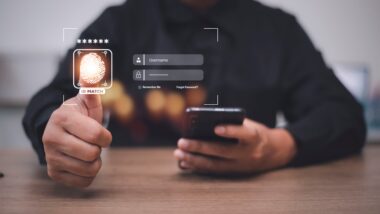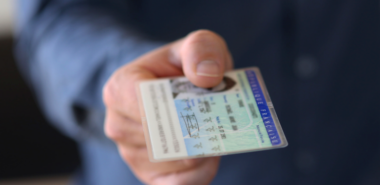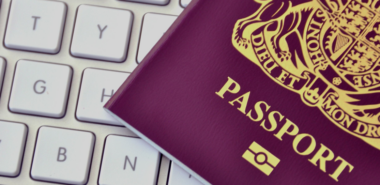
If you’ve been following the buzz about using biometrics in travel and border management, you may have heard the terms biometric modality, multi-modal biometrics, and biometric fusion. If you’re confused about any of those terms you’re not alone. So in this post, we’re going to make sense of them all.
1) What is a biometric modality?
A modality refers to the type of biometric used, so for example, when you verify identity using fingerprints – fingerprint recognition is the chosen modality. If you can only get through a door after an iris scan, iris recognition is the chosen modality.
Follow the traveler’s new biometric journey through the airport in our infographic
Looking at a few of the most common modalities considered for travel and border management, we can talk of facial recognition, fingerprint recognition and iris recognition. Each modality has its pros and cons, which we’ll cover below.
But before that, let’s establish two terms: Reference biometric and Comparison biometric.
- The Reference biometric is the biometric we store on file for a given modality. It has to be of the highest quality possible, because all future biometrics of this person will be compared against this source
- The Comparison biometric is the biometric we capture to verify a person’s identity. It is always checked against the Reference biometric for that modality. This is also sometimes referred to as the “live scan” or “live capture” obtained from the person at the time of the transaction
2) Facial, Fingerprint and Iris Recognition Modalities: Pros and Cons
Facial Recognition is the most accessible, non-invasive biometric modality. A person’s portrait is relatively easy to capture, presumably using any camera and in any reasonably controlled environment.
However, the quality of the reference biometric – the original photo – is crucial. If it’s of poor quality, the resulting biometric comparison will not yield a very high assurance level on the match against comparison images in the future.
Fortunately, tools exist to guide the user through the process of capturing good reference and comparison portrait images by providing real-time feedback. This includes things like avoiding bright light in the background, not having balanced lighting of the face so there are no shadows, and using a neutral background.

In particular, guidelines provided by the ISO/IEC 19794-5 standard serve as reference for the International Civil Aviation Organization (IACO) 9303 standard for passport photographs. This standard imposes scene constraints on lighting, pose, and facial expression. Further photographic properties and digital image attributes such as resolution and size are regulated.
The 700+ million electronic passports in circulation in 2017 provide a huge opportunity to implement face recognition at international borders.
Moving on to our second most common modality, let’s talk about Fingerprint Recognition.
Fingerprint has a strong pro; you have more data than with facial or iris, because you can collect prints from all ten fingers, instead of two eyes and one face.
Fingerprint biometrics is a mandatory feature of ePassports for the members of the European Union, where data is also protected by a specific protection mechanism. It is also widely used in Africa for biometric voter registration and verification.
The greatest challenge is to capture the reference biometric, i.e. the fingerprints that all future fingerprints will be verified against.

Why is this? The answer is that reference fingerprints need to be captured in a very controlled environment. And people often need to be guided through the process with a lot of prompts, explanations, and in many cases literal hand-holding, to get a high-quality reference set on file.
And as many may know, there’s a certain effort you need to make when scanning your fingerprints for verification. You need to place your fingers on the scanner just so, sometimes holding still and other times rolling the finger a bit.
And there’s a high rate of human error, which can make the process longer. It’s not uncommon for a person to scan the wrong finger. E.g. you’re requested to present your left index finger, and you scan your right middle finger on the scanner.
And finally, let’s consider Iris Recognition.
Iris has the advantage of being both very accurate and accommodating of extra-ordinary situations – for example, when women wear headdresses that prevent facial recognition.
On the other hand, iris scanning takes a lot of user engagement and patience; both for the capture of the reference iris image and then for subsequent verifications. It requires specialized equipment and lighting, and the traveler needs to stare at the scanner without moving for several seconds while being scanned.
With each modality having its pros and cons, you really need to consider the use case, the big picture when choosing which modality to use. Specifically, in the case of the traveler’s experience, we need to consider both the risk factors and the friction the modality would create.
3) Multi-Modal Biometrics: Why they’re needed
When it comes to border management, you need to achieve a high level of confidence that the person crossing the border is who they claim to be. It’s one of those high stakes situations where certainty really matters.
Governing agencies define what assurance level is sufficient for each passenger use case, e.g. to get through security to the gate, to get on to the plane, to cross a border, etc.
The assurance level needs to match the risk level of the use case.
Sometimes, if you can’t reach the assurance level using one modality, you’ll want to deploy a secondary one. And that’s what we call multi-modal biometrics, also sometimes referred to biometric fusion, or just “fusion.” When used together to create a combined score, multiple modalities can increase the biometric certainty about a person’s identity.
Here are a couple of tangible examples:
You recently lost a lot of weight and look quite different from your reference facial biometric. If facial recognition at an eGate returns a low assurance level, you may be prompted to also provide your fingerprint for verification. This is an example of ad-hoc multi-modal biometrics – the second modality is used on an as-needed basis.
Here’s a different example of systematic multi-modal biometrics: At a specific airport, facial recognition is used to get through security and to the gate. At the gate, in order to board the plane, fingerprint recognition is also required. The second biometric is always required, systematically.
Borders of the future
Facial, fingerprint and iris biometric modalities are going to play a bigger and bigger role in the traveler’s journey. The technology for capturing reference biometrics and comparison biometrics is also evolving at a fast pace. As biometrics become more commonplace at airports and borders, technology will continue to evolve and improve in order to increase traveler security while reducing friction in the traveler’s experience.
Read more about identity and biometrics on Gemalto’s Biometrics Resource Center


